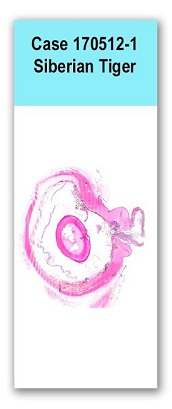Case 1 170512-1 (17B0309)
Conference Coordinator: Molly Liepnieks
//
Male tiger greater than 14 years old.
The patient is an inbred tiger with a history of left-sided corneal ulceration that has been managed for approximately ten months. There has been minimal corneal edema and no neovascularization. The ulcer remained quiescent until it suddenly ruptured. Enucleation was performed twelve days later. Patient was treated with oral enrofloxacin, famciclovir (started 3/31), lysine, tramadol. The right eye also has a small ulcer and possibly a sequestrum. A Corynebacterium sp. (2+ growth) was cultured from both eyes. Serology was negative for feline leukemia virus, feline coronavirus, feline immunodeficiency virus, feline herpesvirus, Leptospira spp., Toxoplasma spp. and Cryptococcus spp. A corneal impression smear demonstrated marked neutrophilic inflammation with no visible infectious agents.
The entire eye (formalin-fixed) was received for histopathology. The cornea was perforated and an approximately 1.5 cm x 0.5 cm x 0.5 cm, brown mass of tissue (presumably iris) protruded from the surface.
One section of the entire globe is present on this slide. The cornea is centrally disrupted by a broad, full-thickness perforation with prolapse of the markedly edematous iris. The margins of the cornea at the point of rupture are covered by a single layer of attenuated epithelium that extends inward towardw Descemet's membrane. The cornea contains a few, scattered, fragmented neutrophils and the stroma lacks clefting (indicative of edema) particularly in the region adjacent to the perforation. There is a focal region in the corneal stroma adjacent to the defect in which spindle cells appear to be decreased in number. There are few, small caliber blood vessels within the superficial cornea that extend 1-3 mm from the limbus. The iris is expanded by clear space (edema), and it is infiltrated by small numbers of lymphocytes. There is a focal accumulation of necrotic neutrophils surrounded by cellular debris. The outer margins of the iris are multifocally necrotic and are covered by fibrin. A few mononuclear inflammatory cells are in the inferior ocular chambers. The sclera and conjunctiva have multifocal accumulations of lymphocytes with fewer plasma cells. There is marked suprachoroidal expansion by edema, congestion, and hemorrhage. The retina is artifactually disrupted. The lens has scattered to coalescing regions of morgagnian globules (cortical cataracts).
A McDonald's stain was performed, but background staining of cells and debris within the iris hindered accurate interpretation. There was no clear evidence of bacterial infection based on that section.
Chronic corneal perforation with iris prolapse
Mild, chronic neutrophilic keratitis
Suprachoroidal congestion and hemorrhage
Mild, chronic lymphocytic, neutrophilic anterior uveitis
Extensive cortical cataract
Examination of the globe confirmed the presence of a full thickness, chronic perforation with iris prolapse. Epithelium lining the defect indicates that it has been present for several days, and this is consistent with the clinical history. Inflammation within the cornea is relatively mild, compared to reported cytology results. There is a focal decrease in keratocytes, suggestive of a sequestrum. However, sequestra are typically surrounded by more inflammatory cells than were evident in this case. No bacteria were identified with sections stained hematoxylin and eosin or the McDonald’s variation of the Gram stain. The cause of the perforation was not determined, but tear film deficiencies (quantitative or qualitative) and the potential of underlying or prior herpesviral infection were considered. There is a loose association with herpesviral infections and feline corneal sequestra.
Corneal sequestra are typically characterized by noninflammatory necrosis of stromal keratocytes, and usually there is a slight orange discoloration. However, discoloration may be absent in early lesions. Chronic sequestra tend to be surrounded by mononuclear cells and a few giant cells. Sequestra may occur secondary to dessication in predisposed breeds such as Persian and Himalayan cats. They can also be an uncommon sequela to any corneal ulceration.
Wilcock BP, Njaa BL. 2015 Special senses. in Jubb, Kennedy, and Palmer’s Pathology of domestic animals. Ed M. Grant Maxie 1:407-508.
Stiles J, McDermott M, Bigsby D, Willis M, Martin C, Roberts W, Greene C. 1997. Use of nested polymerase chain reaction to identify feline herpesvirus in ocular tissue from clinically normal cats and cats with corneal sequestra or conjunctivitis. American Journal of Veterinary Research. 58(4):338-42.
Grahn BH, Sisler S, Storey E. 2005 Qualitative tear film and conjunctival goblet cell assessment of cats with corneal sequestra. Veterinary Ophthalmology. 8(3):167-70.

